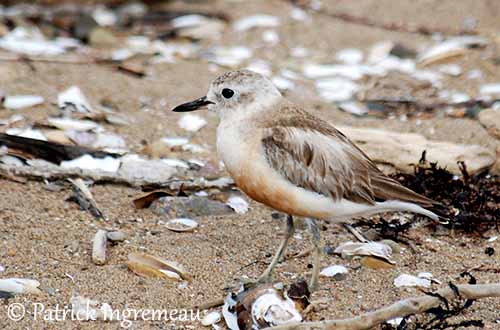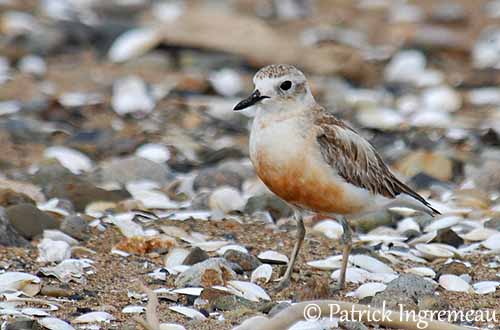
Fr: Pluvier roux - Gravelot roux
Maori: Tuturiwhatu
Ang: New Zealand Plover or Dotterel - Red-breasted Plover
All: Maoriregenpfeifer
Esp: Chorlito Maorí
Ita: Piviere della Nuova Zelanda
Nd: Rosse Plevier
Sd: Maoripipare
Photographers:
Ken Havard
My Bird Gallery & Flickr gallery 1 & Flickr gallery 2
Patrick Ingremeau
TAMANDUA
Text by Nicole Bouglouan
Sources:
HANDBOOK OF THE BIRDS OF THE WORLD Vol 3 by Josep del Hoyo-Andrew Elliott-Jordi Sargatal - Lynx Edicions - ISBN : 8487334202
KNOW YOUR NEW ZEALAND BIRDS by Lynnette Moon - New Holland Publishers – ISBN: 1869660897
SHOREBIRDS by Peter Hayman, John Marchant and Tony Prater – Christopher Helm – 1986 – ISBN: 0747014035
BirdLife International (BirdLife International)
New Zealand bird status between 2008 and 2012
Te Ara – The Encyclopedia of New Zealand
New Zealand birds and birding (Narena Olliver)
New Zealand Plover
(Other names: New Zealand Dotterel or Red-breasted Plover)
Charadrius obscurus
Charadriiformes Order – Charadriidae Family
INTRODUCTION:
The New Zealand Plover is the largest of the dotterels in New Zealand. Its cryptic plumage makes the bird inconspicuous on the sand and shells of beaches where it nests.
This plover is an Endangered species with small remaining populations, after being formerly common and widespread throughout its range.
DESCRIPTION OF THE BIRD:
Biometrics:
Length: 25 cm
Wingspan: 46-50 cm
Weight: Race “aquilonius”: 146 g – Race “obscurus”: 160 g
The New Zealand Plover is a bulky shorebird. The adult of northern race aquilonius has brown upperparts. The underparts are white outside breeding season, and become orange-red in breeding plumage. The extent of this colour may vary individually and according to the season.
The feathers of the upperparts are edged tawny-chestnut on head, mantle, scapulars and tertials, whereas wing-coverts are edged white. There is a white wingbar, more conspicuous in flight. The rump is greyish-brown. The central pair of rectrices is dark brown with darker tip. The outer two pairs are paler brown with white edges.
On the underparts, the chestnut-red colour occurs mainly on lower breast, belly and flanks. Vent and undertail-coverts are usually white, like the underwing.
On the head, forehead and supercilium are white, becoming chestnut in breeding plumage. Crown, lores and ear-coverts are brown to grey-brown.
The heavy bill is black. The eyes are dark brown. Legs and feet are grey.

The adult in non-breeding plumage has paler upperparts with pale grey fringes.
On the underparts, chin and throat are white, whereas the upperbreast is washed and spotted with grey-brown, and sometimes flanks too. The rest of underparts are white.
The adult of nominate race “obscurus” (not displayed) is darker overall, with darker brown upperparts and darker orange-red underparts. The head is dark too and more uniformly coloured.
The bird is paler and duller outside the breeding season.
Males are usually darker than females, but their plumage pattern is similar.
The juvenile resembles non-breeding adult. The upperparts are darker brown with buffish-tawny fringes to feathers. On the underparts, there are some brownish spots on the breast with tawny fringes. Rest of underparts are washed warm buffish-tawny. Head and neck sides are paler and the crown is dark brown.
SUBSPECIES AND RANGE:
There are two subspecies:
C.o. aquilonius (here displayed) is found in North Island, New Zealand. It occurs on both coasts, from Kawhia northwards on the W coast, and from North Cape southwards along the E coast of Northland, Auckland, the Coromandel Peninsula and Bay of Plenty, and farther south in Mahia Peninsula.
C.o. obscurus (not displayed) occurs on Stewart Island where a small population of about 250 individuals is surviving.
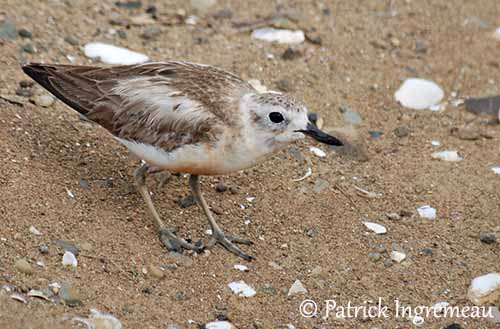
HABITAT:
The New Zealand Plover of race aquilonius usually breeds on sandy or shell beaches in marine harbours, and a few birds on gravel beaches. They often gather around stream mouths. The birds living in urban areas may breed inland on short grassy areas such as golf courses, or on bare ground.
The southern birds of nominate race obscurus that breed on Stewart Island establish their nest-sites on exposed subalpine grasslands and in rocky areas above the tree-line, up to 300 metres of elevation.
CALLS AND SONGS: SOUNDS BY XENO-CANTO
The New Zealand Plover’s typical calls are rolling “trrrt” and “turr” given while chasing intruders. The bird utters high-pitched “pweeps” while bobbing the head when disturbed or threatened. The common call “chip” is also used as contact call. The territorial disputes with neighbours are accompanied by sharp “werr-wit”.
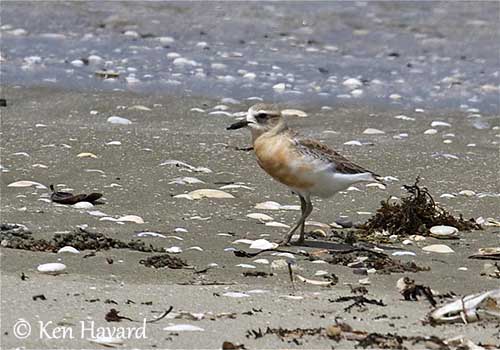
BEHAVIOUR IN THE WILD:
The New Zealand Plover feeds in flocks outside the breeding season, often at large estuaries. It feeds on a variety of invertebrates, both aquatic and terrestrial. It walks while searching for preys and performs the typical “run-stop-peck”. It picks at the surface on wet sand near stream mouths where it finds molluscs and crustaceans, and it may take occasionally small fish. But it also forages in grassy areas and takes crickets, moths and earth worms.
The New Zealand Plover is monogamous and the pairs have long-term pair-bonds. They are usually solitary nesters, but they can form small groups of 2-10 pairs, with widely spaced nests and strongly defended territories.
In early spring, the male gains the chestnut-red breast feathers which play an important role in courtship and threat displays.
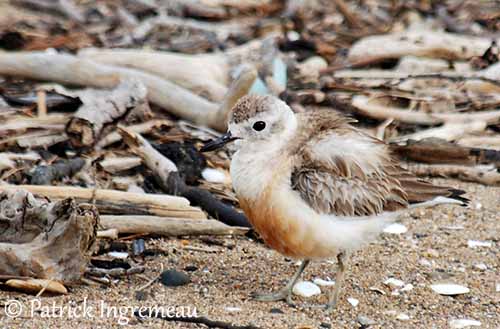
The New Zealand Plover of race aquilonius from North Island is mainly sedentary, and some birds remain on their territories all year round. It only performs short-distance movements between the breeding grounds and the post-breeding sites where it returns every year.
The race obscurus leaves the high breeding areas and reaches the coast. The juveniles often disperse and reach the S coast of South Island.
The flight is fast and agile.
REPRODUCTION OF THIS SPECIES:
The breeding season takes place between August and December.
The northern race aquilonius nests on broad expanses of sand, often near brackish or flowing freshwater.
The southern race obscurus on Stewart Island nests on rocky highlands.
The race aquilonius builds a shallow scrape in the soil, with some lining or decoration with driftwood or vegetation.
The female lays 3 cryptic-coloured eggs in August-September. Both parents incubate during 28-32 days. The chicks are covered with buffy-white down with darker markings. They fledge about 6 weeks after hatching. If a brood is lost, the pair may produce up to 4 replacement clutches.
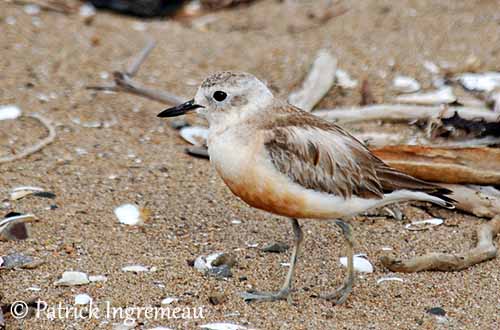
The race obscurus nests in hollows between rocks or in cushion plants. The nests are well-lined with grass. The laying occurs later, from October. Incubation and fledging periods are unknown, but they are probably similar to those of the previous.
In both races, the chicks are precocial and leave the nest soon after hatching. The adults commonly perform distraction displays such as “broken-wing” display, in order to lead intruders or predators away from the nest.
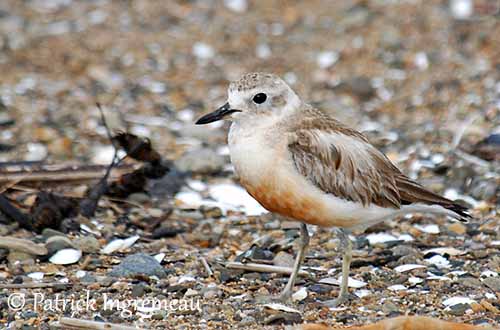
PROTECTION / THREATS / STATUS:
The New Zealand Plover is threatened by egg and chick predators such as cats, stoats, hedgehogs and rats. The adults can be killed by cats and stoats during the breeding season when they are incubating on the ground and by avian predators such as gulls and hawks.
The nests placed on the shoreline can be destroyed by spring tides and storms. In addition, due to their cryptic colour, eggs and chicks are vulnerable to vehicles and dogs on beaches.
Protection programme with predator control and fencing of nesting areas are underway for the race aquilonius. The population is estimated at about 2175 individuals (2011).
On Stewart Island, a population of about 250 birds (2005) is surviving and nests on mountain tops.
Both species are Threatened/Naturally Vulnerable.
The New Zealand Plover is an Endangered species.
